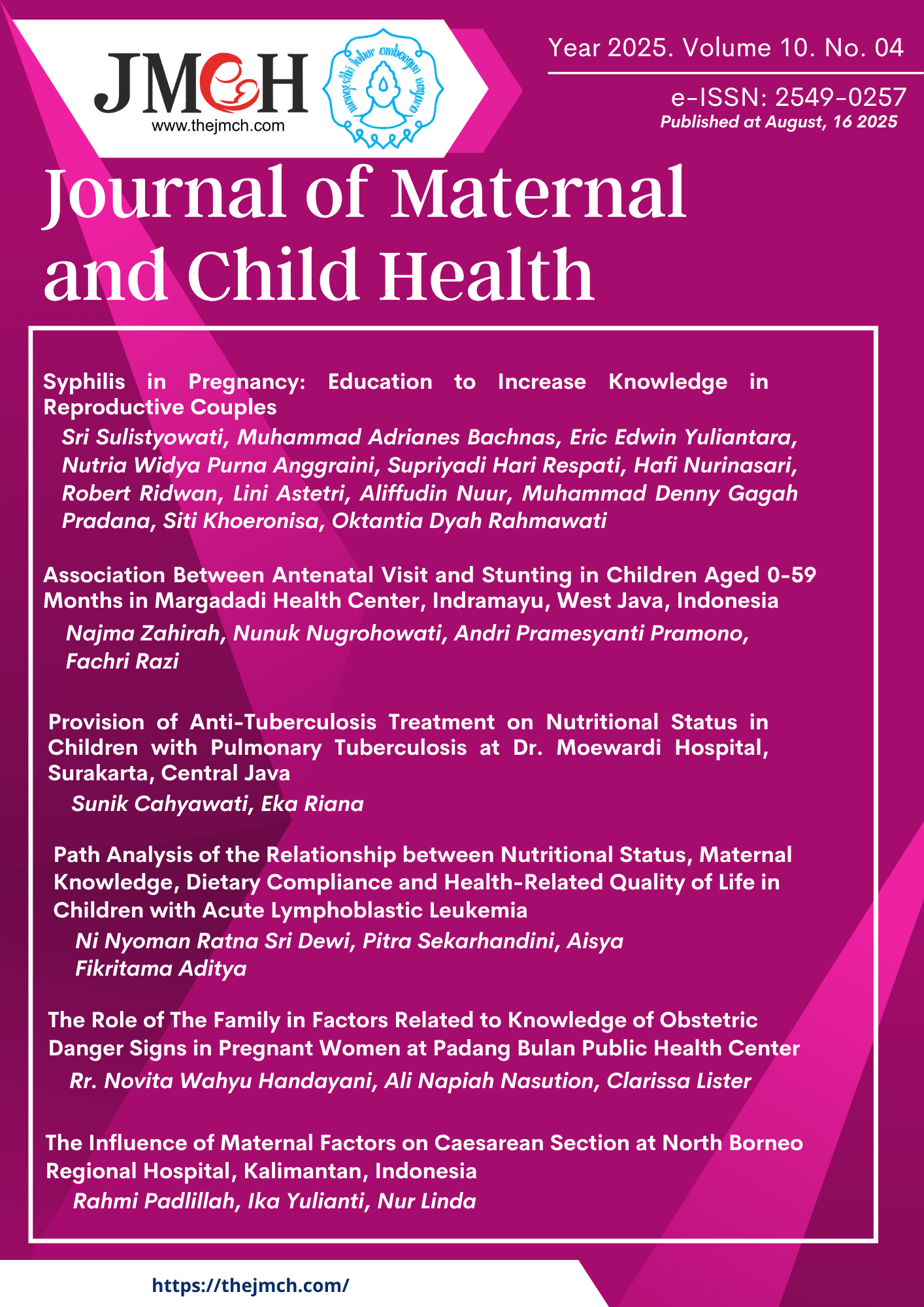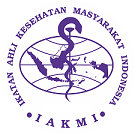Correlation between Blood Sodium and CD4 Level in Pediatrics with Human Immunodeficiency Virus Infection
DOI:
https://doi.org/10.26911/thejmch.2025.10.04.04Abstract
Background: Electrolyte disorders such as hyponatremia are often found in human immunodeficiency virus (HIV) patients. It is closely correlated with HIV morbidity and mortality. Sodium levels have also been reported to correlate with cluster of differentiation 4 (CD4) in adult subjects, but it is not yet known how in children with HIV infection.This study conducted to analyze the correlation between electrolyte levels, especially sodium, and CD4 levels in children with HIV infection.
Subjects and Method: Descriptive analytical study with a cross-sectional design. The subjects were 42 pediatric HIV patients aged 0-18 years who were willing to undergo sodium and CD4 level examinations. Subjects with liver cancer, liver cirrhosis and cardiovascular disease and opportunistic infections in HIV were excluded. Subjects were selected by consecutive sampling. The dependent variables was blood sodium levels, while the independent variables was CD4 counts, and the confounding variables were age, and ARV duration use. Sodium levels were measured using the Cbs400, Jokoh ex-d and smarlyte devices while CD4 levels were measured using the BD FACSCount device by flow cytometry. The correlation between sodium and ARV duration use on CD4 levels analyzed by Pearson test, while correlation between patient’s age and CD4 levels analyzed by Spearman rank test. The multiple linear regression used to control the confounding variables.
Results: The average sodium level in pediatric HIV patients at Dr. Moewardi Surakarta Regional General Hospital (Mean= 131.19; SD= 5.68 mEq/L), while the average CD4 level (Mean= 940.40; SD= 464.81 cells/μL). Pearson test showed a positive and weak correlation between sodium levels and CD4 counts (r= 0.32; p = 0.040), meaning that the higher the sodium level, the higher the CD4 count. There was a negative and very weak correlation with the duration of ARV use (r= -0.18; p= 0.254), meaning that the higher the sodium level, the lower the CD4 count. Spearman Rank test showed a correlation between age and CD4 count (r= -0.52; p<0.001), meaning that the older the person, the lower the CD4 count. The results of linear regression showed that there was a significant influence between sodium levels on CD4 count (b= 24.99; p= 0.029) and patient age (b= -55.21; p=0.003).
Conclusion: Sodium levels have a moderate positive correlation with CD4 levels in pediatric patients with HIV infection. Examination of sodium levels can be an additional parameter in routine monitoring of the immunodeficiency status of pediatric HIV patients.
Keywords:
Sodium, CD4, HIVHow to Cite
References
Adrian N, Rahayuningsih SE, Alam A (2021). Korelasi cluster of differentiation 4 dan viral load dengan fungsi sistolik ventrikel kiri pada anak dengan human immunodeficiency virus (Correlation of cluster of differentiation 4 and viral load with left ventricular systolic function in children with human immunodeficiency virus) Sari Pediatri. 23(2): 103–109. doi: 10.14238/sp23.2.2021.1039.
Aurelina R (2020). Faktor-faktor yang berhubungan terhadap kadar cluster of differentiation 4 (Cd4) pada pasien Hiv/Aids (Factors related to cluster of differentiation 4 (Cd4) levels in HIV/AIDS patients). Jurnal Medika Hutama. 02(01):308–313.
Braconnier P, Delforge M, Garjau M, Wissing KM, De Wit S (2017). Hyponatremia is a marker of disease severity in hiv-infected patients: A retrospective cohort study. BMC Infectious Diseases. 17(1):1–10. doi: 10.1186/s1287901721915.
Dumitru C, Kabat AM, Maloy KJ (2018). Metabolic adaptations of cd4+ t cells in inflammatory disease. Frontiers in Immunology. 15;9:540. doi: 10.3389/fimmu.2018.00540.
Gao ZR, Yuan Z, Zhao C, Zhao R, Zhang Q (2023). Better predictive value of lymphocyte count and hemoglobin for CD4 level of HIV patients. Current HIV Research. 21(1): 73–80. doi: 10.2174/1570162X21666221222104349.
Hayes EV (2024). Human immuno-deficiency virus and acquired immunodeficiency syndrome. Nelson Text-book of Pediatrics. 302:1778–1805.
Kandel S, Khadka S, Lamsal M, Jha B, Paudyal S, Gautam S, Poudel S, et al (2021). Low cluster of differentiation 4+ t cell count in people living with hiv/aids undergoing antiretroviral therapy visiting a reference laboratory: A descriptive cross-sectional study. Journal of the Nepal Medical Association. 59(237):486–489. doi: 10.31729/JNMA.6062.
Luo T, Ji WJ, Yuan F, Guo ZZ, Li YX, Dong Y, Bla B (2016). TH17/TREG imbalance induced by dietary salt variation indicates inflammation of target organs in humans. Scientific Reports. 29;6:26767. doi: 10.1038/srep26767.
Musso CG, Belloso WH, Glassock RJ (2016). Water, electrolytes, and acidbase alterations in human immunodeficiency virus infected patients. World Journal of Nephrology. 5(1):33. doi: 10.5527/wjn.v5.i1.33.
Okoye AA, Picker LJ (2013). CD4(+) T-cell depletion in HIV infection: mechanisms of immunological failure. Immunological Reviews. 254(1):54–64. doi: 10.1111/imr.12066.
Prianggandanni MA, Lestari AA, Wande IN, Mahartini NN, Herawati S (2023). Correlation between tlymphocyte CD4+ and total lymphocyte count (TLC), hemoglobin, neutrophil to lymphocyte ratio (NLR) and tlymphocyte CD4+/CD8+ ratio in HIV patients at Prof. Dr. I.G.N.G Ngoerah Hospital, Denpasar, Bali, Indonesia. Bali Medical Journal. 12(2):2017–2021. doi: 10.15562/bmj.v12i2.4342.
Ritarwan K, Pujiastuti RA, Ginting PN (2022). Correlation between hyponatremia and cluster of differentiation 4 in response to highly active antiretroviral therapy treatment in patients with human immunodeficiency virus cerebral toxoplasmosis. Open Access Macedonian Journal of Medical Sciences. 10(8):1315–1318. doi: 10.3889/oamjms.2022.8956.
Selik RM, Mokotoff ED, Branson B, Owen SM, Whitmore S, Hall HI (2014). Revised surveillance case definition for HIV infection-United States, 2014. Recommendations and Reports. 63(3):1–10.
Sharp PM, Hahn BH (2011). Origins of HIV and the AIDS pandemic. Cold Spring Harbor Perspectives in Medicine. 1(1). doi:10.1101/cshperspect.a006841.
Shu Z, Tian Z, Chen J, Ma J, Abudureyimu A, Qian Q, Zhuo L (2018). AIDS-related hyponatremia an old but still serious problem. Renal Failure. 40(1):68–74. doi: 10.1080/0886022X.2017.1419975.
Wilck N, Balogh A, Markó L, Bartolomaeus H, Müller DN (2019). The role of sodium in modulating immune cell function. Nature Reviews Nephrology. 15(9):546–558. doi: 10.1038/s415810190167y.
Xu L, Ye H, Huang F (2014). Moderate/ severe hyponatremia increases the risk of death among hospitalized chinese human immunodeficiency virus/acquired immunodeficiency syndrome patients. PLoS ONE. 9(10):111-117. doi: 10.1371/journal.pone.0111077.
Yi B, Titze J, Rykova M, Feuerecker M (2015). Effects of dietary salt levels on monocytic cells and immune responses in healthy human subjects: a longitudinal study. Transl Res. 166(1): 103–110. doi: 10.1016/j.trsl.2014.11.007. Epub 2014 Nov 22.
Zhang L, Zhong H, Wei B, Fan J, Huang J, Li Y, Liu W (2022). Establishing reference values for peripheral blood lymphocyte subsets of healthy children in China using a single platform. Journal of Immunology Research. 22(1):1–10. doi: 10.1155/2022/560-3566.











